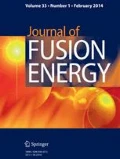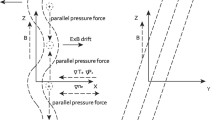Abstract
Future generation fusion reactors and tokamaks will require dissipative divertors to handle the high particle and heat loads leaving the core plasma (100–400 MW/m2 in ITER). A radiative divertor is proposed as a possible scenario, utilizing a hydrogen target gas to disperse the plasma momentum and trace impurity radiation to dissipate the plasma heat flux. Introducing an impurity into the target hydrogen gas enhances the radiative power loss but may lead to a significant impurity backflow to the main plasma. Thus, impurity flow control represents a crucial design concern. Such impurity flows are studied experimentally in this thesis. The PISCES-A linear plasma device (n ≤ 3 × 1019 m−3, kT e ≤ 20 eV) has been used to simulate a gas target divertor. To study the transport of impurities, a trace amount of impurity gas (i.e., neon and argon) is puffed near the target plate along with the hydrogen gas. Varying the hydrogen gas puffing rate permits us to study the effects of various background plasma conditions on the transport of impurities. A 1-1/2-D fluid code has been developed to solve the continuity and momentum equations for a neutral and singly ionized impurity in a hydrogen background plasma. The results indicate an axial reduction in the impurity concentration upstream from the impurity puffing source. Impurity entrainment is more effective for higher hydrogen target pressures (and for higher hydrogen plasma densities). However, if there is a reversal of the background plasma flow, impurity particles can propagate past the plasma flow reversal point and are then no longer entrained.
Similar content being viewed by others
REFERENCES
W. L. Barr and B. G. Logan, Fusion Technol. 18, 251 (1990).
G. Bekefi, Radiation Processes in Plasmas (Wiley, New York, 1966).
S. I. Braginskii, in Reviews of Plasma Physics, edited by M. A. Leontovich (Consultants Bureau, New York, 1965), Vol. 1.
F. F. Chen, Introduction to Plasma Physics (Plenum Press, New York, 1974).
D. M. Goebel, G. Campbell, and R. W. Conn, “Plasma Surface Interaction Experimental Facility (PISCES) for Materials and Edge Physics Studies,” in Proceedings of the Symposium on Energy Removal and Particle Control in Fusion Devices, Princeton, NJ, U.S.A. 26–29 July 1983, J. Nucl. Mat. 121, 277-82 (1984).
Y. Hirooka et al., Progress Report for 1992–1993 on Plasma-Materials Interactions and Edge-Plasma Physics Research (UCLA PPG #1485, Los Angeles, Dec. 1993).
Hershkowitz, in Plasma Diagnostics, edited by O. Auciello and D. L. Flamm (Academic Press, Boston, 1989).
W. L. Hsu, M. Yamada, and P. J. Barret, Phys. Rev. Lett. 49, 1001 (1982).
J. D. Huba, NRL Plasma Formulary, 1994.
Yu. L. Igitkhanov, Contrib. Plasma Phys. 28, 447 (1988).
G. Janeschitz, K. Borass, G. Federici, Y. Igikhanov, A. Kukushkin, H. D. Pacher, G. W. Pacher, and M. Sugihara, “The ITER Divertor Concept”, in Proceedings of the 11th International Conference on Plasma-Surface Interactions in Controlled Fusion Devices, Mito Japan, May 1994, J. Nucl. Mat. 220-222, 73-88 (1995).
R. V. Jensen, D. E. Post, W. H. Grasberger, C. B. Tarter, and W. A. Lokke, Nucl. Fusion 17, 1187 (1977).
E. W. McDaniel et al., Ion-Molecule Reactions (Wiley-Interscience, New York, 1970).
R. W. P. McWhirter, in Plasma Diagnostic Techniques, edited by R. H. Huddlestone and S. L. Leonard (Academy Press, New York, 1965).
M. Petravic, Phys. Plasmas 1, 2077 (1994).
L. Schmitz, L. Blush, G. Chevilier, R. Lehmer, Y. Hirooka, P. Chia, G. Tynan, and R. W. Conn, “Impurity Transport and Retention in a Gas Target Divertor: Simulation Experiments in PISCES-A and Modeling Results,” J. Nucl. Mat. 196-198, 841 (1992).
L. Schmitz, B. Merriman, L. Blush, R. Lehmer, R.W. Conn, R. Doerner, A. Grossman, F. Najmabadi, “Plasma and Neutral Dynamics in a Simulated Tokamak Gas Target Divertor,” Phys. Plasmas 2 (8), 3081-3094 (1995).
L. Schmitz, B. Merriman, A. Grossman, F. Najmabadi, and R.W. Conn, Bull. Am. Phys. Soc. 39, 1712 (1994).
L. Schmitz, B. Merriman, and B. Lee, “Momentum Removal, Radiative Cooling, and Plasma Detachment in Dissipative Divertors,” Bull. Am. Phys. Soc. 40 (11), 1729 (1995).
L. Schmitz et al., “Heat Flux Retention and Impurity Screening in a Gas Target Divertor,” in Plasma-Materials Interactions and Edge-Plasma Physics Research (Pisces Progress Report, Los Angeles, 1991–1992).
W. M. Stacey, Jr., Fusion Plasma Analysis (John Wiley & Sons, New York, 1981).
See National Technical Information Service Document No. MATT-1050 (F. H. Tenney and G. Lewin, in Princeton Plasma Physics Laboratory Report No. MATT-1050, 1974, p. 75). Copies may be ordered from the National Technical Information Service, Springfield, VA 22161.
M. L. Watkins and P.-H. Rebut, in Proceedings of the 19th European Conference on Controlled Fusion and Plasma Physics, Innsbruck, Austria, 1992 (European Physical Society, Geneva, 1992), Vol. 16C, Part II, p. 731.
A. Y. Wong, Introduction to Experimental Plasma Physics, (Physics Department, UCLA, 1977).
Author information
Authors and Affiliations
Rights and permissions
About this article
Cite this article
Blush, L.M., Schmitz, L., Merriman, B. et al. Impurity Transport in a Simulated Gas Target Divertor. Journal of Fusion Energy 19, 115–142 (2000). https://doi.org/10.1023/A:1013918212432
Issue Date:
DOI: https://doi.org/10.1023/A:1013918212432




